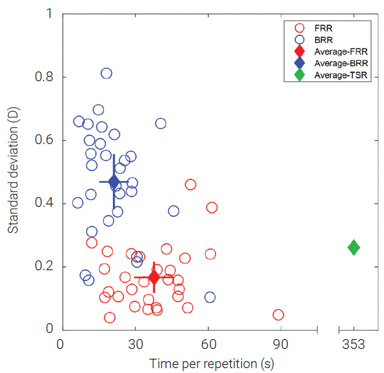 [Enlarge image]Standard deviation versus time per repetition for flicker-minimization (FRR, red), blur-minimization (BRR, blue), and traditional subjective refraction (TSR, green).
[Enlarge image]Standard deviation versus time per repetition for flicker-minimization (FRR, red), blur-minimization (BRR, blue), and traditional subjective refraction (TSR, green).
In the condition of refractive error—myopia, hyperopia and astigmatism—the eye’s optics do not correctly focus the images on the retina. Numerous techniques are available for measuring refractive error. Objective refraction techniques are typically rapid measurements that do not need active participation by the patient. Subjective refraction techniques rely on the patient’s responses in tasks such as letter identification, blur comparison or blur minimization. Clinicians still consider traditional subjective refraction the gold standard for evaluating refractive error, as it incorporates the visual feedback from the patient.1 This approach involves testing various lenses until the patient can recognize the smallest letters on a chart.2
However, the traditional subjective refraction method has several disadvantages. Accommodation—the eye’s ability to change its focusing position—has a strong influence in the procedure, leading to inaccurate prescriptions. To reduce accommodation’s influence, a fogging technique is used, but this increases measurement time. Moreover, subjective refraction is a time-consuming procedure, entailing the full dedication of a well-trained eye care professional for an average of more than 6 minutes,1 and for much longer with some patients. It also has high variability (from ±0.20 to 0.38 D), which can be significant in practice.3
In a study this year,4 we reported progress on a novel method for estimating the spherical equivalent of the eye, which we call direct subjective refraction. The disruptive working principle hinges on the use of quick defocus changes, in combination with a bichromatic stimulus (made of blue and red components) to create a chromatic flicker. The quick change in defocus produces a flicker perception on the stimulus, which has a stronger effect on blue components when the subject is myopic and on red components when the subject is hyperopic. The flicker is at a minimum with the optimal prescription (see video). Therefore, the task of the subject is to minimize the flicker rather than to identify letters as in the traditional method.
This method based on flicker minimization reduced measurement time and increased repeatability compared with both the traditional method and with an unsupervised version of the traditional method. The improvement of this method lies in the fact that the eye’s accommodation response barely influences the procedure; instead, the eye stays in a fixed focusing position due to the impossibility of following the fast defocus change. This largely eliminates the main disadvantage of the traditional subjective refraction method.
We believe this study shows the potential of direct subjective refraction in providing fast, accurate and unsupervised subjective measurements of refractive error. The method is now being adapted to the clinic, including extension to the measurement of astigmatism and miniaturization of the device.
Researchers
Victor Rodriguez-Lopez, Institute of Optics, Spanish National Research Council (IO-CSIC), Madrid, Spain
Carlos Dorronsoro, Institute of Optics, IO-CSIC, and 2EyesVision SL, Madrid, Spain
References
1. V. Rodriguez-Lopez and C. Dorronsoro. Curr. Opin. Ophthalmol. 33, 228 (2022).
2. D.B. Elliott. Clinical Procedures in Primary Eye Care, 3rd ed., Butterworth-Heinemann (2008).
3. D.A. Atchison et al. Ophthalmic Physiol. Opt. 21, 255 (2001).
4. V. Rodriguez-Lopez et al. Biomed. Opt. Express 14, 3671 (2023).
